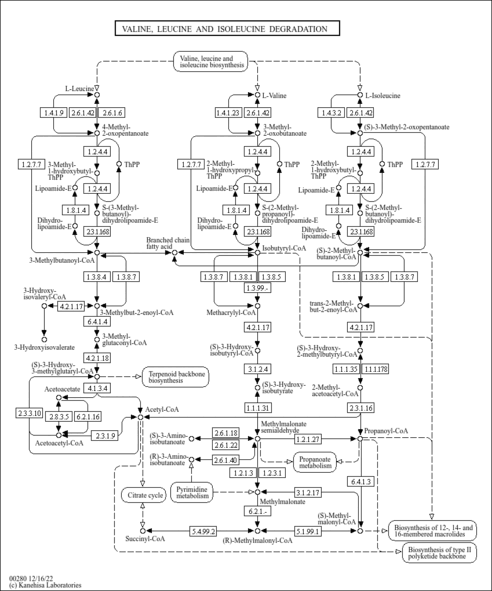Showing Compound Card for 2-Methylacetoacetyl-CoA (CDB005127)
| Record Information | ||||||||||||||||||||||||||||||||||||||||||||||||||||||||||
|---|---|---|---|---|---|---|---|---|---|---|---|---|---|---|---|---|---|---|---|---|---|---|---|---|---|---|---|---|---|---|---|---|---|---|---|---|---|---|---|---|---|---|---|---|---|---|---|---|---|---|---|---|---|---|---|---|---|---|
| Version | 1.0 | |||||||||||||||||||||||||||||||||||||||||||||||||||||||||
| Created at | 2020-04-17 19:12:02 UTC | |||||||||||||||||||||||||||||||||||||||||||||||||||||||||
| Updated at | 2020-12-07 19:11:38 UTC | |||||||||||||||||||||||||||||||||||||||||||||||||||||||||
| CannabisDB ID | CDB005127 | |||||||||||||||||||||||||||||||||||||||||||||||||||||||||
| Secondary Accession Numbers | Not Available | |||||||||||||||||||||||||||||||||||||||||||||||||||||||||
| Cannabis Compound Identification | ||||||||||||||||||||||||||||||||||||||||||||||||||||||||||
| Common Name | 2-Methylacetoacetyl-CoA | |||||||||||||||||||||||||||||||||||||||||||||||||||||||||
| Description | 2-Methylacetoacetyl-CoA, also known as S-(2-methyl-3-oxobutanoate, belongs to the class of organic compounds known as 3-oxo-acyl coas. These are organic compounds containing a 3-oxo acylated coenzyme A derivative. 2-Methylacetoacetyl-CoA is a strong basic compound (based on its pKa). 2-Methylacetoacetyl-CoA is a potentially toxic compound. 2-Methylacetoacetyl-CoA is expected to be in Cannabis as all living plants are known to produce and metabolize it. | |||||||||||||||||||||||||||||||||||||||||||||||||||||||||
| Structure | ||||||||||||||||||||||||||||||||||||||||||||||||||||||||||
| Synonyms |
| |||||||||||||||||||||||||||||||||||||||||||||||||||||||||
| Chemical Formula | C26H42N7O18P3S | |||||||||||||||||||||||||||||||||||||||||||||||||||||||||
| Average Molecular Weight | 865.63 | |||||||||||||||||||||||||||||||||||||||||||||||||||||||||
| Monoisotopic Molecular Weight | 865.152 | |||||||||||||||||||||||||||||||||||||||||||||||||||||||||
| IUPAC Name | {[5-(6-amino-9H-purin-9-yl)-4-hydroxy-2-({[hydroxy({[hydroxy(3-hydroxy-2,2-dimethyl-3-{[2-({2-[(2-methyl-3-oxobutanoyl)sulfanyl]ethyl}carbamoyl)ethyl]carbamoyl}propoxy)phosphoryl]oxy})phosphoryl]oxy}methyl)oxolan-3-yl]oxy}phosphonic acid | |||||||||||||||||||||||||||||||||||||||||||||||||||||||||
| Traditional Name | 2-methylacetoacetyl-coa | |||||||||||||||||||||||||||||||||||||||||||||||||||||||||
| CAS Registry Number | 6712-01-2 | |||||||||||||||||||||||||||||||||||||||||||||||||||||||||
| SMILES | CC(C(C)=O)C(=O)SCCNC(=O)CCNC(=O)C(O)C(C)(C)COP(O)(=O)OP(O)(=O)OCC1OC(C(O)C1OP(O)(O)=O)N1C=NC2=C(N)N=CN=C12 | |||||||||||||||||||||||||||||||||||||||||||||||||||||||||
| InChI Identifier | InChI=1S/C26H42N7O18P3S/c1-13(14(2)34)25(39)55-8-7-28-16(35)5-6-29-23(38)20(37)26(3,4)10-48-54(45,46)51-53(43,44)47-9-15-19(50-52(40,41)42)18(36)24(49-15)33-12-32-17-21(27)30-11-31-22(17)33/h11-13,15,18-20,24,36-37H,5-10H2,1-4H3,(H,28,35)(H,29,38)(H,43,44)(H,45,46)(H2,27,30,31)(H2,40,41,42) | |||||||||||||||||||||||||||||||||||||||||||||||||||||||||
| InChI Key | NHNODHRSCRALBF-UHFFFAOYSA-N | |||||||||||||||||||||||||||||||||||||||||||||||||||||||||
| Chemical Taxonomy | ||||||||||||||||||||||||||||||||||||||||||||||||||||||||||
| Description | Belongs to the class of organic compounds known as 3-oxo-acyl coas. These are organic compounds containing a 3-oxo acylated coenzyme A derivative. | |||||||||||||||||||||||||||||||||||||||||||||||||||||||||
| Kingdom | Organic compounds | |||||||||||||||||||||||||||||||||||||||||||||||||||||||||
| Super Class | Lipids and lipid-like molecules | |||||||||||||||||||||||||||||||||||||||||||||||||||||||||
| Class | Fatty Acyls | |||||||||||||||||||||||||||||||||||||||||||||||||||||||||
| Sub Class | Fatty acyl thioesters | |||||||||||||||||||||||||||||||||||||||||||||||||||||||||
| Direct Parent | 3-oxo-acyl CoAs | |||||||||||||||||||||||||||||||||||||||||||||||||||||||||
| Alternative Parents |
| |||||||||||||||||||||||||||||||||||||||||||||||||||||||||
| Substituents |
| |||||||||||||||||||||||||||||||||||||||||||||||||||||||||
| Molecular Framework | Aromatic heteropolycyclic compounds | |||||||||||||||||||||||||||||||||||||||||||||||||||||||||
| External Descriptors | Not Available | |||||||||||||||||||||||||||||||||||||||||||||||||||||||||
| Ontology | ||||||||||||||||||||||||||||||||||||||||||||||||||||||||||
| Disposition | ||||||||||||||||||||||||||||||||||||||||||||||||||||||||||
| Role | ||||||||||||||||||||||||||||||||||||||||||||||||||||||||||
| Physical Properties | ||||||||||||||||||||||||||||||||||||||||||||||||||||||||||
| State | Solid | |||||||||||||||||||||||||||||||||||||||||||||||||||||||||
| Experimental Properties |
| |||||||||||||||||||||||||||||||||||||||||||||||||||||||||
| Predicted Properties |
| |||||||||||||||||||||||||||||||||||||||||||||||||||||||||
| Spectra | ||||||||||||||||||||||||||||||||||||||||||||||||||||||||||
| EI-MS/GC-MS | Not Available | |||||||||||||||||||||||||||||||||||||||||||||||||||||||||
| MS/MS |
| |||||||||||||||||||||||||||||||||||||||||||||||||||||||||
| NMR | Not Available | |||||||||||||||||||||||||||||||||||||||||||||||||||||||||
| Pathways | ||||||||||||||||||||||||||||||||||||||||||||||||||||||||||
| Pathways | ||||||||||||||||||||||||||||||||||||||||||||||||||||||||||
| Protein Targets | ||||||||||||||||||||||||||||||||||||||||||||||||||||||||||
| Enzymes |
| |||||||||||||||||||||||||||||||||||||||||||||||||||||||||
| Transporters | Not Available | |||||||||||||||||||||||||||||||||||||||||||||||||||||||||
| Metal Bindings | Not Available | |||||||||||||||||||||||||||||||||||||||||||||||||||||||||
| Receptors | Not Available | |||||||||||||||||||||||||||||||||||||||||||||||||||||||||
| Transcriptional Factors | Not Available | |||||||||||||||||||||||||||||||||||||||||||||||||||||||||
| Concentrations Data | ||||||||||||||||||||||||||||||||||||||||||||||||||||||||||
| Not Available | ||||||||||||||||||||||||||||||||||||||||||||||||||||||||||
| External Links | ||||||||||||||||||||||||||||||||||||||||||||||||||||||||||
| HMDB ID | HMDB0001157 | |||||||||||||||||||||||||||||||||||||||||||||||||||||||||
| DrugBank ID | Not Available | |||||||||||||||||||||||||||||||||||||||||||||||||||||||||
| Phenol Explorer Compound ID | Not Available | |||||||||||||||||||||||||||||||||||||||||||||||||||||||||
| FoodDB ID | FDB022455 | |||||||||||||||||||||||||||||||||||||||||||||||||||||||||
| KNApSAcK ID | Not Available | |||||||||||||||||||||||||||||||||||||||||||||||||||||||||
| Chemspider ID | 52 | |||||||||||||||||||||||||||||||||||||||||||||||||||||||||
| KEGG Compound ID | C03344 | |||||||||||||||||||||||||||||||||||||||||||||||||||||||||
| BioCyc ID | Not Available | |||||||||||||||||||||||||||||||||||||||||||||||||||||||||
| BiGG ID | 41671 | |||||||||||||||||||||||||||||||||||||||||||||||||||||||||
| Wikipedia Link | 2-Methylacetoacetyl-CoA | |||||||||||||||||||||||||||||||||||||||||||||||||||||||||
| METLIN ID | 6040 | |||||||||||||||||||||||||||||||||||||||||||||||||||||||||
| PubChem Compound | 53 | |||||||||||||||||||||||||||||||||||||||||||||||||||||||||
| PDB ID | Not Available | |||||||||||||||||||||||||||||||||||||||||||||||||||||||||
| ChEBI ID | 15476 | |||||||||||||||||||||||||||||||||||||||||||||||||||||||||
| References | ||||||||||||||||||||||||||||||||||||||||||||||||||||||||||
| General References | Not Available | |||||||||||||||||||||||||||||||||||||||||||||||||||||||||
Enzymes
- General function:
- Involved in transferase activity, transferring acyl groups other than amino-acyl groups
- Specific function:
- Abolishes BNIP3-mediated apoptosis and mitochondrial damage.
- Gene Name:
- ACAA2
- Uniprot ID:
- P42765
- Molecular weight:
- 41923.82
- General function:
- Involved in transferase activity, transferring acyl groups other than amino-acyl groups
- Specific function:
- Not Available
- Gene Name:
- ACAA1
- Uniprot ID:
- P09110
- Molecular weight:
- 34664.46
- General function:
- Involved in transferase activity, transferring acyl groups other than amino-acyl groups
- Specific function:
- Not Available
- Gene Name:
- HADHB
- Uniprot ID:
- P55084
- Molecular weight:
- 51293.955
- General function:
- Involved in oxidoreductase activity
- Specific function:
- Functions in mitochondrial tRNA maturation. Part of mitochondrial ribonuclease P, an enzyme composed of MRPP1/TRMT10C, MRPP2/HSD17B10 and MRPP3/KIAA0391, which cleaves tRNA molecules in their 5'-ends. By interacting with intracellular amyloid-beta, it may contribute to the neuronal dysfunction associated with Alzheimer disease (AD).
- Gene Name:
- HSD17B10
- Uniprot ID:
- Q99714
- Molecular weight:
- 25983.695
- General function:
- Involved in 3-hydroxyacyl-CoA dehydrogenase activity
- Specific function:
- Plays an essential role in the mitochondrial beta-oxidation of short chain fatty acids. Exerts it highest activity toward 3-hydroxybutyryl-CoA.
- Gene Name:
- HADH
- Uniprot ID:
- Q16836
- Molecular weight:
- 36035.11
- General function:
- Involved in catalytic activity
- Specific function:
- Straight-chain enoyl-CoA thioesters from C4 up to at least C16 are processed, although with decreasing catalytic rate.
- Gene Name:
- ECHS1
- Uniprot ID:
- P30084
- Molecular weight:
- 31387.085
